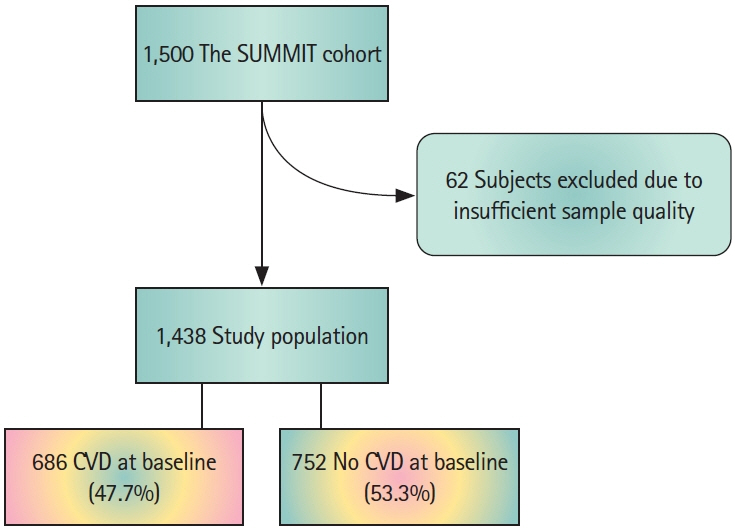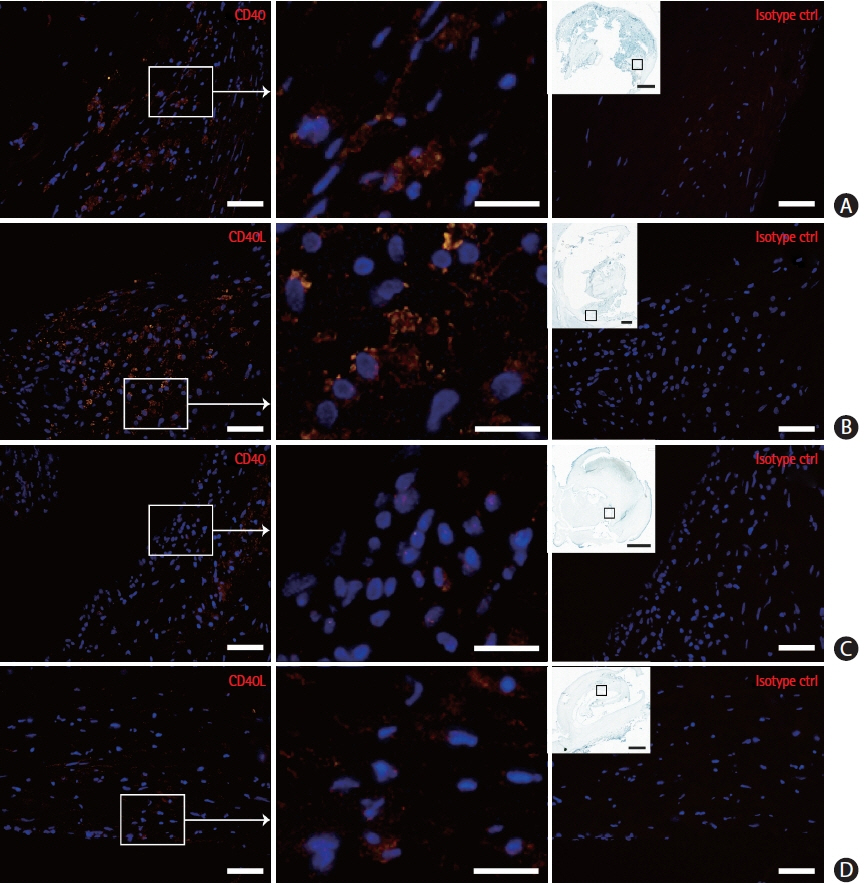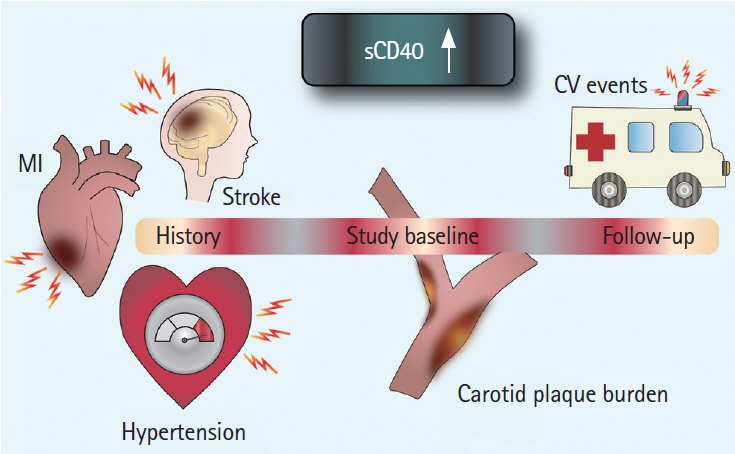J Stroke.
2021 Sep;23(3):367-376. 10.5853/jos.2021.00178.
Soluble CD40 Levels in Plasma Are Associated with Cardiovascular Disease and in Carotid Plaques with a Vulnerable Phenotype
- Affiliations
-
- 1Department of Clinical Sciences Malmo, Clinical Research Center, Lund University, Malmo, Sweden
- 2Department of Cardiology, Skane University Hospital, Lund University, Malmo, Sweden
- 3Diabetes and Vascular Medicine, University of Exeter Medical School, National Institute for Health Research Exeter Clinical Research Facility, Exeter, UK
- 4Department of Clinical and Experimental Medicine, University of Pisa, Pisa, Italy
- 5Division of Molecular and Clinical Medicine, University of Dundee, Dundee, UK
- 6Department of Medical Biochemistry, Amsterdam Cardiovascular Sciences, Amsterdam University Medical Centers, University of Amsterdam, Amsterdam, The Netherlands
- 7Institute for Cardiovascular Prevention (IPEK), Ludwig Maximilian University of Munich, Munich, Germany
- 8German Center for Cardiovascular Research (DZHK), Partner Site Munich Heart Alliance, Munich, Germany
- KMID: 2520914
- DOI: http://doi.org/10.5853/jos.2021.00178
Abstract
- Background and Purpose
CD40 and CD40 ligand (CD40L) are costimulatory molecules of the tumor necrosis factor receptor superfamily and well known for their involvement in inflammatory diseases: atherosclerotic mouse models with disrupted CD40 signalling develop lesions of reduced size with a more stable plaque profile. This study investigated the potential of plasma and intraplaque levels of CD40 and CD40L as markers for cardiovascular disease (CVD) in humans and their association with plaque stability.
Methods
Soluble CD40 and CD40L (sCD40L) were measured in plasma in 1,437 subjects from The SUrrogate markers for Micro- and Macro-vascular hard endpoints for Innovative diabetes Tools (SUMMIT) cohort. Intra-plaque levels of sCD40 and sCD40L were measured in atherosclerotic plaque homogenates from 199 subjects of the Carotid Plaque Imaging Project (CPIP) cohort.
Results
Both plasma sCD40 and sCD40L levels were elevated in individuals with prevalent stroke, while sCD40 levels also were higher in individuals with a prior acute myocardial infarction. Plasma levels of sCD40 correlated with carotid intima-media thickness and total carotid plaque area and were associated with risk of cardiovascular events over a 3-year follow-up period. Intra-plaque levels of sCD40 and sCD40L were associated with plaque components characteristic for plaque vulnerability and extracellular matrix remodelling.
Conclusions
Higher plasma sCD40 and sCD40L levels are associated with prevalent CVD. Plasma sCD40 levels also correlate with the severity of carotid atherosclerosis and predict future cardiovascular events, while intra-plaque levels correlate with a vulnerable plaque phenotype. Our findings thus demonstrate that elevated levels of sCD40 and sCD40L are markers of CVD.
Keyword
Figure
Reference
-
References
1. World Health Organization. Cardiovascular Disease Fact Sheet. Geneva, CH: World Health Organization;2017.2. Sakakura K, Nakano M, Otsuka F, Ladich E, Kolodgie FD, Virmani R. Pathophysiology of atherosclerosis plaque progression. Heart Lung Circ. 2013; 22:399–411.
Article3. Hansson GK, Libby P, Tabas I. Inflammation and plaque vulnerability. J Intern Med. 2015; 278:483–493.
Article4. Noelle RJ, Ledbetter JA, Aruffo A. CD40 and its ligand, an essential ligand-receptor pair for thymus-dependent B-cell activation. Immunol Today. 1992; 13:431–433.
Article5. Jobling K, Ng WF. CD40 as a therapeutic target in Sjögren’s syndrome. Expert Rev Clin Immunol. 2018; 14:535–537.
Article6. Lutgens E, Lievens D, Beckers L, Wijnands E, Soehnlein O, Zernecke A, et al. Deficient CD40-TRAF6 signaling in leukocytes prevents atherosclerosis by skewing the immune response toward an antiinflammatory profile. J Exp Med. 2010; 207:391–404.
Article7. Lutgens E, Gorelik L, Daemen MJ, de Muinck ED, Grewal IS, Koteliansky VE, et al. Requirement for CD154 in the progression of atherosclerosis. Nat Med. 1999; 5:1313–1316.
Article8. Lutgens E, Cleutjens KB, Heeneman S, Koteliansky VE, Burkly LC, Daemen MJ. Both early and delayed anti-CD40L antibody treatment induces a stable plaque phenotype. Proc Natl Acad Sci U S A. 2000; 97:7464–7469.
Article9. Seijkens TTP, van Tiel CM, Kusters PJH, Atzler D, Soehnlein O, Zarzycka B, et al. Targeting CD40-induced TRAF6 signaling in macrophages reduces atherosclerosis. J Am Coll Cardiol. 2018; 71:527–542.
Article10. Garlichs CD, John S, Schmeisser A, Eskafi S, Stumpf C, Karl M, et al. Upregulation of CD40 and CD40 ligand (CD154) in patients with moderate hypercholesterolemia. Circulation. 2001; 104:2395–2400.
Article11. Heeschen C, Dimmeler S, Hamm CW, van den Brand MJ, Boersma E, Zeiher AM, et al. Soluble CD40 ligand in acute coronary syndromes. N Engl J Med. 2003; 348:1104–1111.
Article12. Schönbeck U, Varo N, Libby P, Buring J, Ridker PM. Soluble CD40L and cardiovascular risk in women. Circulation. 2001; 104:2266–2268.
Article13. Huang YQ, Jie LI, Chen JY, Tang ST, Huang C, Feng YQ. The relationship between soluble CD40 ligand level and atherosclerosis in white-coat hypertension. J Hum Hypertens. 2017; 32:40–45.
Article14. Lobbes MB, Lutgens E, Heeneman S, Cleutjens KB, Kooi ME, van Engelshoven JM, et al. Is there more than C-reactive protein and fibrinogen? The prognostic value of soluble CD40 ligand, interleukin-6 and oxidized low-density lipoprotein with respect to coronary and cerebral vascular disease. Atherosclerosis. 2006; 187:18–25.15. de Lemos JA, Zirlik A, Schönbeck U, Varo N, Murphy SA, Khera A, et al. Associations between soluble CD40 ligand, atherosclerosis risk factors, and subclinical atherosclerosis: results from the Dallas Heart Study. Arterioscler Thromb Vasc Biol. 2005; 25:2192–2196.16. Verma S, Wang CH, Li SH, Lonn E, Charbonneau F, Title LM, et al. The relationship between soluble CD40 ligand levels and Framingham coronary heart disease risk score in healthy volunteers. Atherosclerosis. 2005; 182:361–365.
Article17. Gergei I, Kälsch T, Scharnagl H, Kleber ME, Zirlik A, März W, et al. Association of soluble CD40L with short-term and long-term cardiovascular and all-cause mortality. The Ludwigshafen Risk and Cardiovascular Health (LURIC) study. Atherosclerosis. 2019; 291:127–131.
Article18. Shore AC, Colhoun HM, Natali A, Palombo C, Östling G, Aizawa K, et al. Measures of atherosclerotic burden are associated with clinically manifest cardiovascular disease in type 2 diabetes: a European cross-sectional study. J Intern Med. 2015; 278:291–302.
Article19. Asciutto G, Edsfeldt A, Dias NV, Nilsson J, Prehn C, Adamski J, et al. Treatment with beta-blockers is associated with lower levels of Lp-PLA2 and suPAR in carotid plaques. Cardiovasc Pathol. 2013; 22:438–443.
Article20. Kim HL, Kim SH. Pulse wave velocity in atherosclerosis. Front Cardiovasc Med. 2019; 6:41.
Article21. Companjen AR, van der Wel LI, Boon L, Prens EP, Laman JD. CD40 ligation-induced cytokine production in human skin explants is partly mediated via IL-1. Int Immunol. 2002; 14:669–676.
Article22. Basok A, Shnaider A, Man L, Chaimovitz C, Douvdevani A. CD40 is expressed on human peritoneal mesothelial cells and upregulates the production of interleukin-15 and RANTES. J Am Soc Nephrol. 2001; 12:695–702.
Article23. Buhtoiarov IN, Lum H, Berke G, Paulnock DM, Sondel PM, Rakhmilevich AL. CD40 ligation activates murine macrophages via an IFN-gamma-dependent mechanism resulting in tumor cell destruction in vitro. J Immunol. 2005; 174:6013–6022.24. Fouad HH, Al-Dera H, Bakhoum SW, Rashed LA, Sayed RH, Rateb MA, et al. Levels of sCD40 ligand in chronic and acute coronary syndromes and its relation to angiographic extent of coronary arterial narrowing. Angiology. 2010; 61:567–573.
Article25. Lukasik M, Dworacki G, Kufel-Grabowska J, Watala C, Kozubski W. Upregulation of CD40 ligand and enhanced monocyte-platelet aggregate formation are associated with worse clinical outcome after ischaemic stroke. Thromb Haemost. 2012; 107:346–355.
Article26. Blake GJ, Ostfeld RJ, Yucel EK, Varo N, Schönbeck U, Blake MA, et al. Soluble CD40 ligand levels indicate lipid accumulation in carotid atheroma: an in vivo study with high-resolution MRI. Arterioscler Thromb Vasc Biol. 2003; 23:e11–e14.
Article27. Balla J, Magyar MT, Bereczki D, Valikovics A, Nagy E, Barna E, et al. Serum levels of platelet released CD40 ligand are increased in early onset occlusive carotid artery disease. Dis Markers. 2006; 22:133–140.
Article28. Contin C, Pitard V, Delmas Y, Pelletier N, Defrance T, Moreau JF, et al. Potential role of soluble CD40 in the humoral immune response impairment of uraemic patients. Immunology. 2003; 110:131–140.
Article29. Bae SC, Lee YH. Association between CD40 polymorphisms and systemic lupus erythematosus and correlation between soluble CD40 and CD40 ligand levels in the disease: a meta-analysis. Lupus. 2019; 28:1452–1459.
Article30. Durakoğlugil ME, Kocaman SA, Çetin M, Kirbas A, Canga A, Erdoğan T, et al. Increased circulating soluble CD40 levels in patients with slow coronary flow phenomenon: an observational study. Anadolu Kardiyol Derg. 2013; 13:39–44.
Article31. Buchhave P, Janciauskiene S, Zetterberg H, Blennow K, Minthon L, Hansson O. Elevated plasma levels of soluble CD40 in incipient Alzheimer’s disease. Neurosci Lett. 2009; 450:56–59.
Article32. Ridker PM, Everett BM, Thuren T, MacFadyen JG, Chang WH, Ballantyne C, et al. Antiinflammatory therapy with canakinumab for atherosclerotic disease. N Engl J Med. 2017; 377:1119–1131.
Article33. Wirka RC, Wagh D, Paik DT, Pjanic M, Nguyen T, Miller CL, et al. Atheroprotective roles of smooth muscle cell phenotypic modulation and the TCF21 disease gene as revealed by single-cell analysis. Nat Med. 2019; 25:1280–1289.
Article34. Fernandez DM, Rahman AH, Fernandez NF, Chudnovskiy A, Amir ED, Amadori L, et al. Single-cell immune landscape of human atherosclerotic plaques. Nat Med. 2019; 25:1576–1588.
Article35. Cha JK, Jeong MH, Jang JY, Bae HR, Lim YJ, Kim JS, et al. Serial measurement of surface expressions of CD63, P-selectin and CD40 ligand on platelets in atherosclerotic ischemic stroke. A possible role of CD40 ligand on platelets in atherosclerotic ischemic stroke. Cerebrovasc Dis. 2003; 16:376–382.
- Full Text Links
- Actions
-
Cited
- CITED
-
- Close
- Share
- Similar articles
-
- Carotid Ultrasound: Carotid Plaques and Clinical Significance
- Evaluation of Carotid Plaque Using Ultrasound Imaging
- Plasma Fibrinogen Level is Associated with Carotid Plaque Progression in Type 2 Diabetic Patients
- High-Resolusion Magnetic Resonance Imaging of Carotid Atherosclerotic Plaque
- Carotid ultrasound in patients with coronary artery disease




